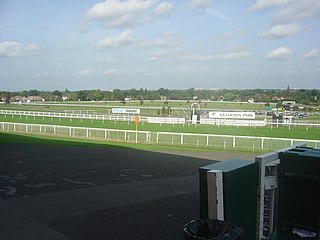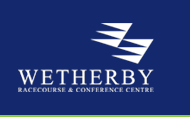Related Research Articles

Caerleon is a town and community in Newport, Wales. Situated on the River Usk, it lies 5 miles (8 km) northeast of Newport city centre, and 5.5 miles (9 km) southeast of Cwmbran. Caerleon is of archaeological importance, being the site of a notable Roman legionary fortress, Isca Augusta, and an Iron Age hillfort. Close to the remains of Isca Augusta are the National Roman Legion Museum and the Roman Baths Museum. The town also has strong historical and literary associations: Geoffrey of Monmouth elevated the significance of Caerleon as a major centre of British history in his Historia Regum Britanniae, and Alfred Lord Tennyson wrote Idylls of the King (1859–1885) while staying in Caerleon.

Lingfield Park Racecourse is a horse racing course at Lingfield in Surrey, United Kingdom. It is owned by the ARC Racing and Leisure Group, formerly Arena Leisure Plc.
In horse racing in the United Kingdom, France and Republic of Ireland, National Hunt racing requires horses to jump fences and ditches. National Hunt racing in the UK is informally known as "jumps" and is divided into two major distinct branches: hurdles and steeplechases. Alongside these there are "bumpers", which are National Hunt flat races. In a hurdles race, the horses jump over obstacles called hurdles; in a steeplechase the horses jump over a variety of obstacles that can include plain fences, water jump or an open ditch. In the UK the biggest National Hunt events of the year are generally considered to be the Grand National and the Cheltenham Gold Cup.

Ascot Racecourse is a dual-purpose British racecourse, located in Ascot, Berkshire, England, which is used for thoroughbred horse racing. It hosts 13 of Britain's 36 annual Flat Group 1 horse races and three Grade 1 Jumps races.

Aintree Racecourse is a racecourse in Aintree, Metropolitan Borough of Sefton, Merseyside, England, bordering the city of Liverpool. The racecourse is the venue for the Grand National steeplechase, which takes place annually in April over three days. Aintree also holds meetings in May and June, October (Sunday), November and December.

Newbury Racecourse is a racecourse and events venue in the civil parish of Greenham, adjoining the town of Newbury in Berkshire, England. It has courses for flat races and over jumps. It hosts one of Great Britain's 36 annual Group 1 flat races, the Lockinge Stakes.
Warwick Racecourse is a horse racing course in Warwick, England. It is a National Hunt racing course and has a programme of 25 meetings throughout the year, many of which are televised. The first stand was built in 1808, and its most recent redevelopment was completed in 2018. In the racecourse is a nine-hole golf course and a golf driving range. The area is a popular place for local people to walk their dogs. There is parking next to the course and it is a five-minute walk away from the town centre.

Sandown Park is a horse racing course and leisure venue in Esher, Surrey, England, located in the outer suburbs of London. It hosts 5 Grade One National Hunt races and one Group 1 flat race, the Eclipse Stakes. It regularly has horse racing during afternoons, evenings and on weekends, and also hosts many non racing events such as trade shows, wedding fairs, toy fairs, car shows and auctions, property shows, concerts, and even some private events. It was requisitioned by the War Department from 1940-1945 for World War II. The venue has hosted bands such as UB40, Madness, Girls Aloud, Spandau Ballet and Simply Red. The racecourse is close to Esher railway station served by trains from London Waterloo. There is a secondary exit from Esher station which is open on race days, this exit leads directly into the racecourse and Lower Green, Esher.

Wetherby Racecourse is a racecourse situated near the market town of Wetherby in West Yorkshire, England, located 12 miles (19 km) from Leeds city centre. For most of its history the course has hosted only National Hunt racing but staged its first Flat racing fixture in April 2015.
The Pony Turf Club was a body which regulated the racing of horses of under 15 hands in the United Kingdom from its foundation in 1923 until the early 1950s.
The Coral Welsh Grand National is a Premier Handicap National Hunt steeplechase in Great Britain which is open to horses aged four years or older. It is run at Chepstow, Wales, over a distance of about 3 miles and 6½ furlongs, and during its running there are twenty-three fences to be jumped. It is a handicap race, and it is scheduled to take place each year on 27 December.
Chepstow Racecourse is a thoroughbred horse racing course located just north of the town of Chepstow in Monmouthshire, Wales, near the southern end of the Wye Valley and close to the border with England. It is one of 16 racecourses operated by the Arena Racing Company and is home of the richest race in Wales, the Coral Welsh Grand National.
Fakenham Racecourse is a thoroughbred horse racing venue located south of Fakenham, Norfolk, England. King Charles III is patron.
Chelmsford City racecourse, originally known as Great Leighs Racecourse, is a thoroughbred horse racing venue located in Great Leighs near Chelmsford, Essex, England. When it opened in April 2008, it was the first entirely new racecourse in the UK since Taunton opened in 1927. It went into administration in January 2009, and racing did not resume until January 2015.

Hereford Racecourse is a horse racing venue located in Hereford, Herefordshire, England, owned by Herefordshire Council and operated by Arena Racing Company.
Musselburgh Racecourse is a horse racing venue located in the Millhill area of Musselburgh, East Lothian, Scotland, UK, close to the River Esk. It is the second biggest racecourse in Scotland and is the fourteenth biggest in the UK. In 2016, Musselburgh staged 28 fixtures. It was officially known as "Edinburgh Racecourse", and referred to as such in the English press, until the beginning of 1996 but was widely referred to as "Musselburgh" in Scotland long before that and was widely referred to as Musselburgh in the racing pages of Scottish newspapers.
Sedgefield Racecourse is an English left-handed horse racing course, used for jump racing. It is owned by Arena Racing Company and located close to the town of Sedgefield, County Durham.
Windsor Racecourse, also known as Royal Windsor Racecourse, is a thoroughbred horse racing venue located in Windsor, Berkshire, England. It is one of only two figure-of-eight courses in the United Kingdom, the other being at Fontwell Park.
The Ffos Las racecourse is a Welsh horse racing, equestrian sports and conferencing venue situated in Ffos Las, Wales. The Ffos Las racecourse was built at the site of an open cast coal mine after mining operations ceased.

Bromford Bridge Racecourse was a racecourse in the Bromford area of Birmingham, England. Its official name was 'Birmingham'. It staged flat and national hunt racing.
References
- ↑ Pitt, Chris (2006). A Long Time Gone (Rev. and updated ed.). Halifax: Portway. pp. 390–393. ISBN 1901570622.
- ↑ "International Cross Country Championships, Caerleon 1951". Caerleon.net. Retrieved 30 December 2022.
- ↑ Monmouthshire XXIX.9 (Map). 25 inch England and Wales, 1841-1952. Ordnance Survey. 1920. Retrieved 28 January 2023.
